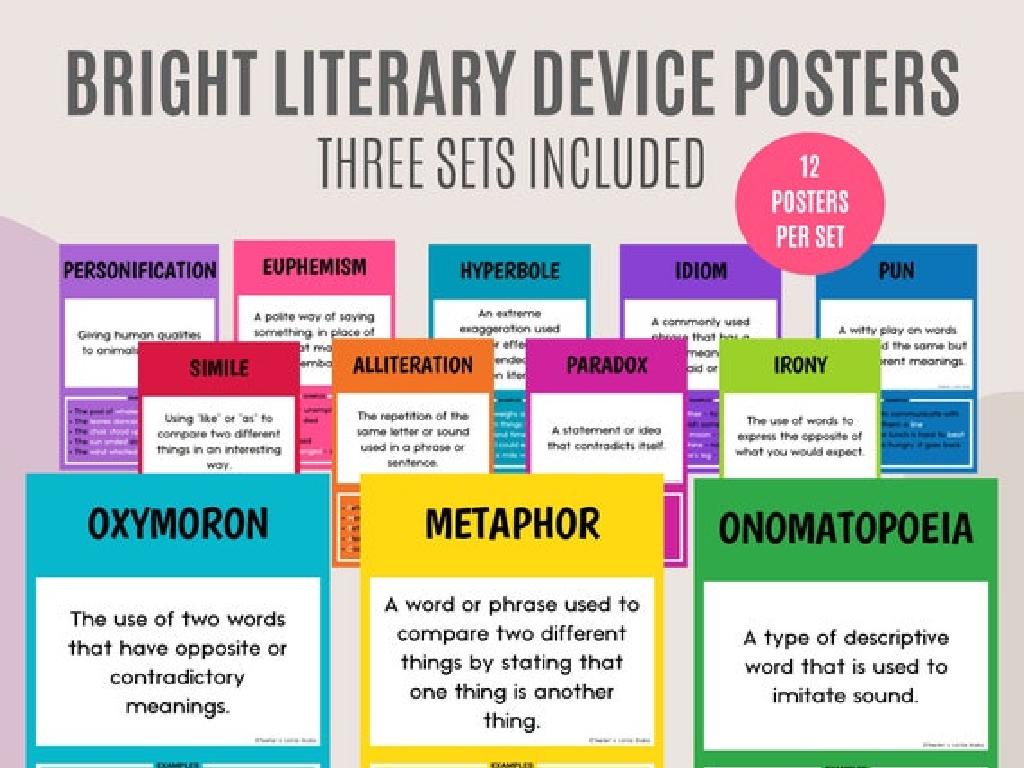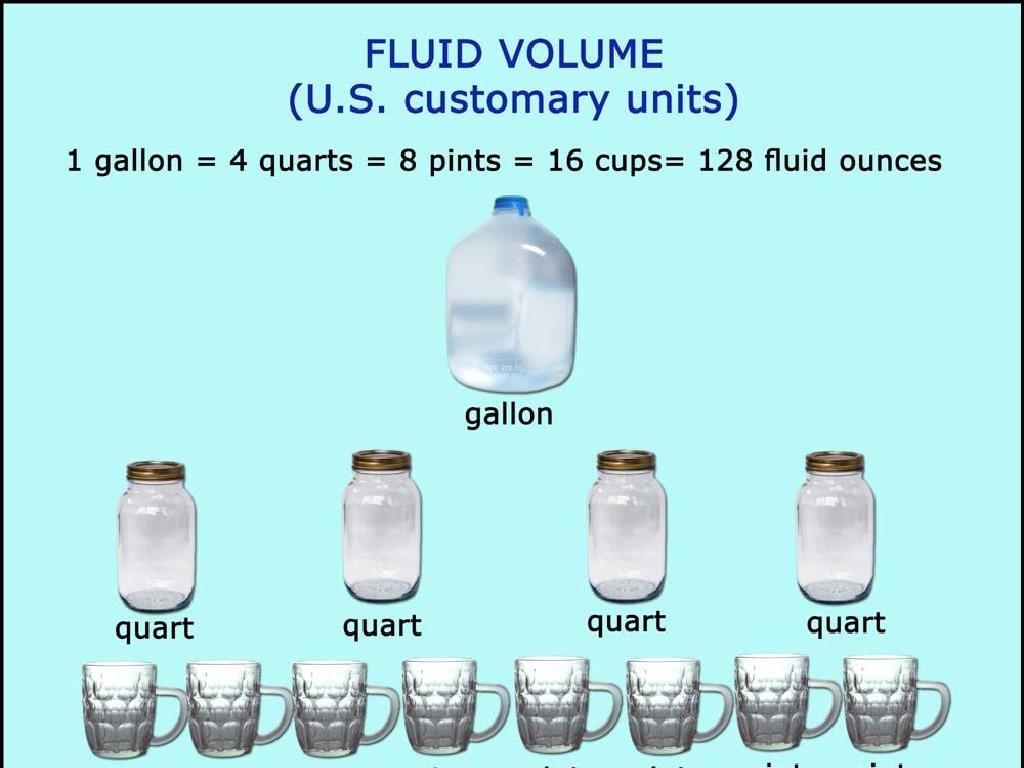Compare And Convert Customary Units Of Weight
Subject: Math
Grade: Fourth grade
Topic: Customary Units Of Measurement
Please LOG IN to download the presentation. Access is available to registered users only.
View More Content
Understanding Customary Units of Weight
– What is weight?
– Weight measures how heavy something is.
– Units: Pounds and Ounces
– 1 pound = 16 ounces. Use what’s appropriate for the object’s heaviness.
– Importance of measuring weight
– To cook, shop, or mail packages, knowing weight is essential.
– Converting between units
– Learn how many ounces are in a pound and practice converting.
|
This slide introduces students to the concept of weight and its importance in everyday life. Begin by explaining that weight is a measure of how heavy an object is and can be measured in pounds and ounces. Emphasize that different situations require different units of measurement. For example, we use pounds to measure our body weight and ounces for smaller items like food. Discuss why measuring weight is crucial, such as for cooking accurately, shopping for groceries, or sending mail. Finally, teach students how to convert between pounds and ounces, providing them with a simple formula and examples to practice. Encourage students to bring examples from home for hands-on learning.
Understanding Customary Units of Weight
– What are customary units?
– Units of measurement used in the U.S.
– Common weight units: oz, lb, T
– Ounces (oz), pounds (lb), and tons (T) are used for weighing objects.
– Examples: oz, lb, and T items
– A pencil weighs about 0.5 oz, a textbook about 5 lb, and a small car about 1 T.
– Converting between units
– Learn how to change ounces to pounds, and pounds to tons.
|
This slide introduces students to the customary units of weight commonly used in the United States. It’s important to familiarize them with ounces, pounds, and tons, as these are the units they will encounter in everyday life. Provide relatable examples to help them grasp the concept of each unit’s weight. For instance, a pencil is light and measured in ounces, while a textbook is heavier and measured in pounds. A small car represents a weight measured in tons. Emphasize the practicality of understanding these units for tasks like cooking, shipping, or assessing the weight of pets. Additionally, teach the students the basic conversions between these units: 16 ounces in a pound, and 2000 pounds in a ton. Include practice problems to reinforce these concepts.
Understanding Ounces and Pounds
– Ounces (oz) to pounds (lb) conversion
– 1 pound equals 16 ounces
– Remember, 1 lb is the same as 16 oz
– Examples: Weighing everyday items
– Fruits or small classroom objects can illustrate this
– Practice conversions with class activity
– Convert 5 lb to oz and 32 oz to lb as examples
|
This slide introduces students to the concept of weight measurement in customary units, specifically ounces and pounds. Start by explaining that ounces are smaller units of weight, while pounds are larger. Use tangible examples like fruits or classroom objects to help students grasp the concept of weight. Demonstrate how to convert pounds to ounces and vice versa, emphasizing the fixed conversion rate: 1 pound equals 16 ounces. Engage the class with a hands-on activity where they practice converting between ounces and pounds using items they are familiar with. This will help solidify their understanding of the relationship between these two units of weight.
Hands-On Activity: Estimating Weight
– Guess weights of classroom items
– Measure weight using a scale
– Use a scale to find the real weight of each item in ounces (oz) or pounds (lb)
– Record weights in ounces/pounds
– Compare guesses to actual weights
– How close were your estimates to the real weights?
|
This interactive activity is designed to help students understand and estimate the weight of objects, which is a practical application of customary units of weight. Start by asking students to guess the weight of various items found in the classroom. Then, have them use a scale to measure the actual weight of these items in ounces or pounds. Students should record their estimates and the actual measurements on a chart. After measuring, students will compare their estimated weights with the actual weights to see how close they were. This will help them develop a better sense of how much things weigh. Possible items for the activity could include a textbook, a pencil, an apple, or a water bottle. Encourage students to explain their estimation process and discuss why their estimates might have differed from the actual measurements.
Converting Ounces to Pounds
– Understanding ounces and pounds
– 1 pound equals 16 ounces. How many pounds are in 8 ounces?
– Multiplication and division for conversion
– Use multiplication to convert pounds to ounces, and division to convert ounces to pounds.
– Practice: 32 oz to pounds
– Convert 32 ounces to pounds using division by 16.
– Group activity: Recipe conversions
– Work together to convert recipe measurements from ounces to pounds.
|
This slide introduces the concept of converting ounces to pounds, a key skill in understanding customary units of weight. Start by explaining that 1 pound is equal to 16 ounces. Use simple multiplication and division to show how to convert between these units. Provide a practice problem for the class to solve together, converting 32 ounces to pounds. Then, engage the class in a group activity where they convert the amounts of ingredients in a recipe from ounces to pounds, fostering collaboration and practical application of the concept. For the activity, prepare different recipes with varying ingredient measurements to cater to each group, ensuring that all students can participate and practice the conversion.
Converting Pounds to Tons
– Understanding the ton unit
– A ton is a much larger unit of weight than a pound.
– 1 ton equals 2,000 pounds
– Remember this key conversion for calculations.
– Real-life examples: cars, elephants
– Cars can weigh about 2 tons, elephants can be 6 tons or more.
– Practice conversion problems
|
This slide introduces students to the concept of weight conversion between pounds and tons, which are both customary units of weight. Emphasize that a ton is a larger unit used to measure very heavy objects, such as cars and elephants. Provide the conversion rate that 1 ton is equal to 2,000 pounds and ensure students memorize this for future calculations. Use relatable examples like the weight of common large objects to help them grasp the concept. Finally, prepare some practice problems for students to convert pounds to tons and vice versa to reinforce their understanding.
Class Activity: Conversion Relay
– Work in teams for conversion problems
– Each member solves a step and passes on
– Race to finish with correct conversions
– Celebrate the winning team’s success
|
This interactive class activity is designed to encourage teamwork and understanding of customary units of weight conversion. Divide the class into small groups, and provide each team with a set of conversion problems that require multiple steps to solve. Each student in the team is responsible for one step of the conversion process. Once they complete their step, they ‘pass the baton’ to the next team member. The first team to finish all problems correctly wins. Possible activities include converting ounces to pounds, pounds to tons, and vice versa. Ensure that each problem requires a different type of conversion to give all students a chance to practice different skills. Celebrate the winning team to motivate participation and acknowledge their success.
Review and Practice: Customary Units of Weight
– Recap: ounces, pounds, tons
– Understand ounces (oz), pounds (lb), and tons (T) and how they relate
– Interactive Q&A session
– Students take turns asking and answering questions about weight units
– Worksheet activity
– Complete a worksheet with various conversion exercises
– Solve conversion problems
– Apply knowledge to convert between oz, lb, and T
|
This slide is aimed at reinforcing the students’ understanding of the customary units of weight. Begin with a quick recap of the key concepts, ensuring that students can recall the relationship between ounces, pounds, and tons. Proceed with an interactive Q&A session where students can engage by asking and answering questions, fostering a collaborative learning environment. Distribute worksheets with conversion problems for students to solve independently, which will help solidify their understanding of the concepts. As a teacher, be prepared to assist students who may struggle with the conversions and provide additional examples if necessary. Encourage students to explain their reasoning during the worksheet activity to promote critical thinking.
Homework: Customary Units of Weight
– Complete the weight conversion worksheet
– Weigh household items in pounds and ounces
– Use a kitchen scale or a bathroom scale
– Record each item’s weight
– Write down the weight on your worksheet
– Share your findings next class
|
This homework assignment is designed to reinforce the day’s lesson on customary units of weight. Students are tasked with completing a worksheet that will require them to convert weights between pounds and ounces. Additionally, they are to find common household items and use a scale to measure their weight in pounds and ounces, recording their findings. This practical activity helps students understand the real-world application of measurement concepts. In the next class, students will have the opportunity to discuss their findings, allowing them to share their understanding and learn from each other’s experiences. The teacher should remind students to handle scales carefully and seek assistance from an adult if necessary.
Reflecting on Weight Measurements
– Importance of weight understanding
Knowing how to measure and compare weight is essential in many aspects of life.
– Real-life application of weight
We use weight to cook, shop for groceries, and even when mailing packages.
– Class discussion on today’s lesson
– Share your thoughts and feedback
|
As we wrap up today’s lesson on customary units of weight, it’s crucial for students to grasp why these concepts matter. Understanding weight measurements is not just for math class it’s a skill they’ll use in everyday life. Whether they’re following a recipe, comparing product weights for the best buy, or sending a parcel, knowing how to measure and convert weights is key. Encourage the class to discuss how they’ve used weight measurements outside of school and to provide feedback on the lesson. This reflection will help solidify their learning and give you insights into their understanding.






